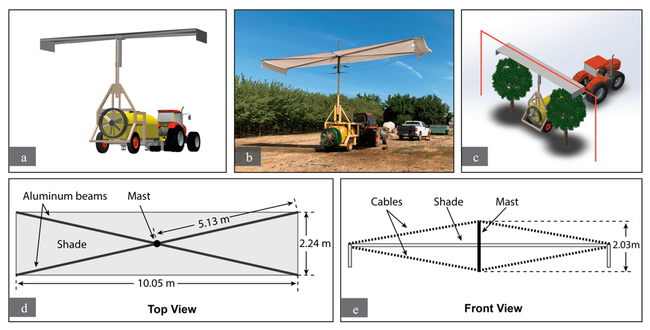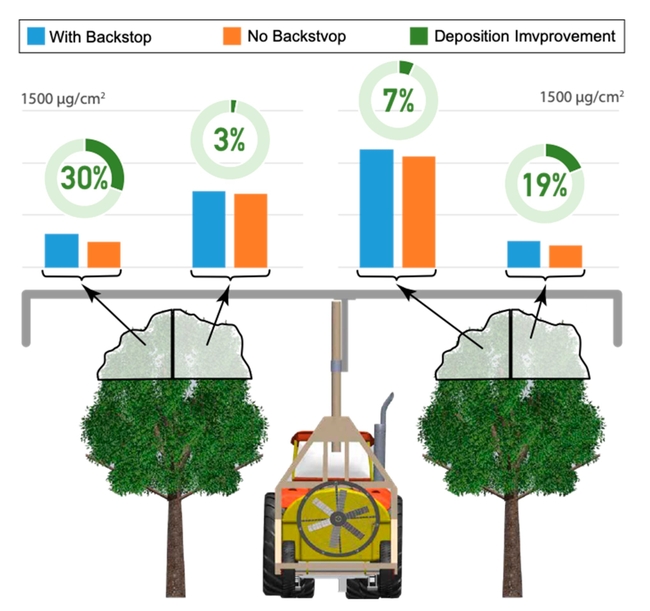UC Digital Agriculture Program's innovative spray backstop system reduces airborne pesticide drift by 78% in almond orchards– a big step forward for improving air quality and working conditions in California's agricultural production areas.
The Issue
Pesticide drift is a significant concern, especially in California's almond orchards. It's not just an environmental issue. Pesticide drift can pose a public health risk by contaminating the skin, lungs, and gut of people in nearby communities. These chemicals can lead to respiratory issues, skin irritation, and other adverse health effects. Another study highlights that pesticide poisoning is a significant cause of morbidity and mortality, affecting not just agricultural workers but also the general population.The challenge has been to control this drift without reducing the effectiveness of the pesticide application. This project aims to tackle this pressing issue head-on.
How UC Delivers
Addressing the issue of pesticide drift requires a multi-disciplinary approach, combining engineering, agriculture, and environmental science expertise. The UC Digital Agriculture Program team rose to the challenge by developing an innovative spray backstop system. This system is a blend of practicality and advanced technology, designed to be both farmer-friendly and effective in reducing pesticide drift.
The core components of this system are a foldable mast and a shade structure. The mast is the backbone, providing the necessary height and stability, while the shade structure acts as a barrier covering the trees from the top. This barrier is crucial in preventing the upward movement of pesticide droplets, thereby reducing the potential for drift.
Figure 1: Schematic design of the backstop prototype installed on a sprayer in an almond orchard.
To validate the effectiveness of this system, a series of tests were conducted in young almond orchards. The sprayer was operated at a 3.2 km/h speed to simulate real-world conditions. But before hitting the field, the team employed advanced uncrewed aerial systems equipped with thermal and RGB cameras. These cameras captured images and videos of the spray pattern from multiple angles, providing invaluable data for analysis.
The aerial imagery was not just for show; it played a pivotal role in the project. It allowed the team to monitor the spray application in real-time and understand the spray cloud's movement pattern. This imagery was then used to refine the design of the shade structure, ensuring it effectively blocked droplet movement beyond the treetop.
Figure 2: Aerial views showing the efficiency of the backstop prototype in blocking the spray cloud.
The results were more than just promising. The backstop system effectively blocked the spray cloud, ensuring that the pesticides stayed precisely where they were intended to be—on the trees. This was further validated through a ribbon test, a simple yet effective method to measure drift. A ribbon placed in the spray path remained in its resting position when the backstop system was used, indicating a significant reduction in drift.
The project didn't stop at just reducing drift; it also ensured that the reduction did not come at the cost of effectiveness. The on-target deposition of the pesticide was not compromised, affirming that the system could achieve dual objectives: reducing drift while maintaining efficacy.
The Impact
The spray backstop system's impact goes beyond just numbers. It represents a significant stride toward sustainable agriculture and community well-being. The system successfully reduced the drift potential by 78%. This isn't merely a statistic; it's a tangible change that has far-reaching implications for both environmental stewardship and human safety.
Figure 3: Statistical results showcasing a significant reduction in drift potential.
The environmental impact is equally noteworthy. Reduced drift means fewer chemicals in the air, contributing to "improved air quality," a UC ANR condition change. This is a step forward in reducing air pollution, which has wide-ranging implications for human health and climate change.
One of the most noteworthy aspects of this innovation is that it managed to reduce drift without compromising the effectiveness of the pesticide application. The on-target deposition remained consistent, ensuring the almond trees received the necessary pesticide coverage for optimal growth and yield. This is a crucial factor for farmers who are often caught in the dilemma of choosing between effective pest control and environmental responsibility.
Figure 4: Comparative leaf samples illustrating consistent on-target deposition and coverage.
The project aligns with another UC ANR's condition change, "improved living and working conditions for California's food system and farm workers." One of the goals of reducing pesticide drift is to mitigate the health risks associated with working and living in agricultural production areas. Therefore, the work directly supports UC ANR's commitment to promoting the public health of California's communities.
Looking ahead, the project has set the stage for further research and development to adapt the system for different types of orchards and terrains. Additional modifications are being considered to make the system even more robust and versatile, ensuring its long-term sustainability and broader applicability.
Want to learn more? See the method in action here.



